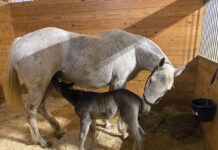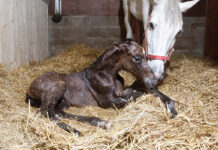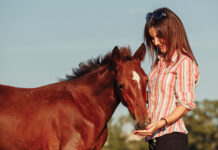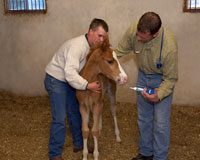 The first months of spring mark the beginning of an important time in your horse’s life—the start of the breeding season. This is the time of year when pheromones fly and everyone’s in the mood for love. Horses are seasonal breeders, and engage in their mating activities during the longer days of the year so that their foals born 340 days later can take advantage of the season’s milder temperatures and lush forages. Horses of both sexes are affected by changes on their hormone levels, which tell them it is time to mate. Longer days stimulate the development of ovarian follicles (cells and fluid surrounding an ovum, or egg) in the mare that secrete estrogen as they grow, bringing the mare into periods of “heat” behavior known as estrus. In the stallion, increasing day length brings about higher blood levels of testosterone, the primary sex hormone responsible for initiating sperm production and stimulating the increase in sexually driven behavior known as libido.
The first months of spring mark the beginning of an important time in your horse’s life—the start of the breeding season. This is the time of year when pheromones fly and everyone’s in the mood for love. Horses are seasonal breeders, and engage in their mating activities during the longer days of the year so that their foals born 340 days later can take advantage of the season’s milder temperatures and lush forages. Horses of both sexes are affected by changes on their hormone levels, which tell them it is time to mate. Longer days stimulate the development of ovarian follicles (cells and fluid surrounding an ovum, or egg) in the mare that secrete estrogen as they grow, bringing the mare into periods of “heat” behavior known as estrus. In the stallion, increasing day length brings about higher blood levels of testosterone, the primary sex hormone responsible for initiating sperm production and stimulating the increase in sexually driven behavior known as libido.
Horse sexual behavior develops a bit differently for colts and fillies. In the first few weeks of life, both colts and fillies can be seen playfully mounting their dams, initially all over the mare’s body but progressively moving toward the haunches. Fillies tend to move past this stage of sexual play after a few weeks and usually do not display further sexually oriented behavior until puberty. Colts continue to engage in playful mounting behavior, mounting their peers as well as their mothers. Colts also start to have occasional penile erections prior to puberty, but their erections are not usually associated with mounting behavior. It is not until horses hit puberty (sometime between their first and second birthdays) that true sexual behavior is initiated.
Beginning with their very first estrus, free-living fillies can be seen assuming the classic breeding posture in front of other horses, particularly stallions. If mature stallions show interest in these young fillies, the fillies often begin to show fear, which overrides the desire to stand for breeding. Pubescent colts, however, may try to mate with fillies in estrus, but are often not yet capable of inseminating them. Sexual behavior is expressed by these post pubertal juveniles, but it is uncommon for breeding to be successful until 2 or 3 years of age.
During the long-daylight period of the year, a typical mature mare will have a five- or six-day period of estrus once every three weeks wherein she may raise her tail, squat, urinate and “wink” her vulva in the presence of other horses, particularly stallions. If she succeeds in finding a mate, the process of courtship begins, which includes all the rituals of smelling, nuzzling, nipping and nickering that mares and stallions engage in prior to breeding. Mares will typically assume a rigid, wide-based stance and will urinate and wink the vulva as the stallion nips and nuzzles the mare, beginning with nose-to-nose contact and working toward the hindquarters. The stallion will usually exhibit the flehmen response, in which he raises his head and curls his upper lip as he sniffs the mare’s urine. By doing this, the stallion is believed to be testing the scents of the mare for readiness to breed by drawing them into his vomeronasal organ, which lies beneath the floor of the nasal cavity. This courtship behavior stimulates both partners by increasing the mare’s secretions to prepare her for breeding while simultaneously enabling the stallion to gain a full erection. The stallion will normally attempt to mount a few times before successfully breeding the mare, which takes less than a minute once intromission has occurred. Following breeding, the stallion will usually rest on the mare’s back for a few seconds, then dismount as the mare moves away. The pair will graze within sight of each other and will periodically repeat courtship and breeding while he mare remains in estrus.
Many geldings are known to engage in stallion-like behavior around mares in estrus, especially if they were gelded after puberty. Since there are both hormonal and instinctual components to this behavior, colts intact at puberty once had normal male sexual responses, even if never allowed to breed. An example of this is Denver Deuce, a horse my mother acquired as a 2-year-old stallion and promptly had gelded. Denver had never been turned out with fillies and had never been used for breeding in his life. Several years later, he was moved to a pasture to live with three mares, one of which was my Appaloosa mare Canela. Every spring, Denver could be seen desperately trying to mount Canela, often with a full erection, and I remember one occasion where I observed him achieve intromission. Denver was extremely possessive of Canela, herding her around the pasture and behaving protectively toward her much the same way a stallion might do with a favorite mare. I have observed other geldings behave similarly when housed with mares. Obviously, testosterone is very important for libido, but some horses are capable of exhibiting sexual behavior in its absence.
How important are sensory cues in courtship? Olfaction appears to be of primary importance for the stallion. Chemical signals in urine help horses to communicate important messages about their readiness for breeding. When the urine of mares in estrus is smeared onto geldings or mares not in estrus, previously uninterested stallions will attempt to breed with these animals. Urinary secretions from mares in estrus are spread onto man-made “mares” to help train stallions to mount a dummy and have semen collected for breeding by artificial insemination.
For mares, tactile and auditory stimulation in addition to olfactory and possibly visual cues appear to be of great importance. The sniffing of the stallion’s muzzle, along with the nuzzling, nipping, licking and nickering done by the stallion all serve to enhance the mare’s receptivity. One study showed that mares displayed estrus in response to taped recordings of stallion vocalizations and/or in response to manual manipulations of their genitalia even in the absence of an actual stallion. (It’s worth noting, however, that similar studies have not duplicated this result.)
As the days get longer, don’t be surprised if your horse acts a bit peculiar. Your mare or stallion may seem distracted and edgy, but this is normal. Try to remember this behavior is to a certain extent beyond your horse’s control. It’s the time of the year when equine reproductive hormones are calling, and your horse is just answering the call of the wild.
Further Reading
Stallion Behavior
Breeding Age for Mares






great article with useful and interesting information
very informative. Information will be very helpful during breeding season.
Good artical.
I am looking for either vidio or books on live cover & Phantom collection.
Any suggestions.
Thanks Dale
Stallion owner
very helpfull and informative. I’ve a paint mare
with a few problems. She is now 2 yrs. old and
was a yearling rack of bones that couldn’t be
sold at auction. I’ve had her in open pasture and
feeding her a mix of grain/feed for a year now.
the man I bought her from can’t belive she is the
same horse. So expect to hear more from me as I will be using this site alot…thank you.
It is ok but could be beter.
hi I wish you had a bit more about older mares and the way in which they will snake away the Stallion when he tries to mount younger mares as i can’t find any information on this.
i stabled my mare with a 7 year old recently gelded stud. I have never seen a mare throw themselves at another horse like she did.constantly . for months. kissing nuzzling grooming. Trying to hug him.
She does not act like that with her 22 year old herd mate, all she does is chase him.
I guess horses can fall in love.
Brilliant, been on the web all night….Best , clearest, informative read so far. Thank you.
Cool!
Hi. I need more information about wild horses. who can help me?